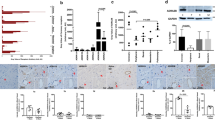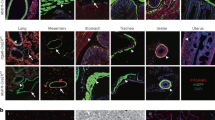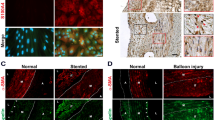Abstract
In this protocol, we describe a method for isolation and culture of smooth muscle cells derived from the adult rat (or mouse) superior mesenteric artery. Arterial myocytes are obtained by enzymatic dissociation and established in primary culture. The cultured cells retain expression of smooth muscle-specific α-actin and physiological responses to agonists. Cultured arterial myocytes (prepared from wild-type or transgenic animals) provide a useful model for studying the regulation of a wide range of vascular smooth muscle responses at the cellular and subcellular levels. Plasmids, RNA interference and antisense oligodeoxynucleotides can be readily introduced into the cells to alter protein expression. Fluorescent dyes can also be introduced to visualize a variety of activities, some of which may be specific to vascular smooth muscle cells. This protocol requires about 3 h on each of 2 consecutive days to complete.
This is a preview of subscription content, access via your institution
Access options
Subscribe to this journal
Receive 12 print issues and online access
$259.00 per year
only $21.58 per issue
Buy this article
- Purchase on Springer Link
- Instant access to full article PDF
Prices may be subject to local taxes which are calculated during checkout



Similar content being viewed by others
References
Waldbilling, D.K. & Pang, S.C. Differential proliferation of rat aortic and mesenteric smooth muscle cells in culture. Histol. Histopathol. 7, 199–207 (1992).
Nakamura, A., Isoyama, S., Watanabe, T., Katoh, M. & Sawai, T. Heterogeneous smooth muscle cell population derived from small and larger arteries. Microvasc. Res. 55, 14–28 (1998).
Orlandi, A., Ehrlich, H.P., Ropraz, P., Spagnoli, L.G. & Gabbiani, G. Rat aortic smooth muscle cells isolate from different layers and at different tomes after endothelial denudation show distinct biological featured in vitro. Arterioscler. Thromb. 14, 982–989 (1994).
Villaschi, S., Nicosia, R.F. & Smith, M.R. Isolation of a morphologically and functionally distinct muscle cell type from the intimal aspect of the normal rat aorta. Evidence for smooth muscle cell heterogeneity. In Vitro Cell Dev. Biol. Anim. 30A, 589–595 (1994).
Frid, M.G., Aldashev, A.A., Dempsey, E.C. & Stenmark, K.R. Smooth muscle cells isolated from discrete compartments of the mature vascular media exhibit unique phenotypes and distinct growth capabilities. Circ. Rec. 81, 940–952 (1997).
Bochaton-Piallat, M.L., Gabbiani, F., Ropraz, P. & Gabbiani, G. Cultured aortic smooth muscle cells from newborn and adult rats show distinct cytoskeletal features. Differentiation 49, 175–185 (1992).
Hao, H., Gabbiani, G. & Bochaton-Piallat, M.-L. Arterial smooth muscle cell heterogeneity. Implications for atherosclerosis and restenosis development. Arterioscler. Thromb. Vasc. Biol. 23, 1510–1520 (2003).
Owens, G. Control of hypertrophic versus hyperplastic growth in vascular smooth muscle cells. Am. J. Physiol. 257, H1755–H1765 (1989).
Ross, R. The pathogenesis of atherosclerosis: a perspective for the 1990. Nature 362, 801–809 (1993).
Chamley-Campbell, J., Campbell, G.R. & Ross, R. The smooth muscle cell in culture. Physiol. Rev. 59, 1–61 (1979).
Halayko, A.J., Salari, H., Ma, X. & Stephens, N.L. Markers of airway smooth muscle cell phenotype. Am. J. Physiol. 270, L1040–L1051 (1996).
Thyberg, J. Differentiated properties and proliferation of arterial smooth muscle cells in culture. Int. Rev. Cytol. 169, 183–265 (1996).
Hall, I.P. & Kotlikoff, M. Use of cultured airway myocytes for study of airway smooth muscle. Am. J. Physiol. 268, L1–L11 (1995).
Golovina, V.A. et al. Upregulated TRP expression and enhanced capacitative Ca2+ entry in human pulmonary artery myocytes during proliferation. Am. J. Physiol. 280, H746–H755 (2001).
Golovina, V.A. & Blaustein, M.P. Spatially and functionally distinct Ca2+ stores in sarcoplasmic and endoplasmic reticulum. Science 275, 1643–1648 (1997).
Davies, M.J. & Hill, M.A. Signaling mechanisms underlying the vesicular myogenic response. Physiol. Rev. 79, 387–423 (1993).
Miriel, V.A., Mauban, J.R.H., Blaustein, M.P. & Wier, W.G. Local and cellular Ca2+ transients in smooth muscle of pressurized rat resistance arteries during myogenic and agonist stimulation. J. Physiol. 518, 815–824 (1999).
Monteith, G.R. & Blaustein, M.P. Heterogeneity of mitochondrial matrix free Ca2+: resolution of Ca2+ dynamics in individual mitochondria in situ. Am. J. Physiol. 276, C1193–C1204 (1999).
Yuan, X.-J., Goldman, W.F., Tod, M.L., Rubin, L.J. & Blaustein, M.P. Ionic currents in rat pulmonary and mesenteric arterial myocytes in primary culture and subculture. Am. J. Physiol. 264, L107–L115 (1993).
Vallot, O. et al. Intracellular Ca2+ handling in vascular smooth muscle cells is affected by proliferation. Arterioscler. Thromb. Vasc. Biol. 20, 1225–1235 (2000).
Berk, B.D. Vascular smooth muscle growth: autocrine growth mechanisms. Physiol. Rev. 81, 999–1030 (2001).
Slodzinski, M.K., Juhaszova, M. & Blaustein, M.P. Antisense inhibition of Na+/Ca2+ exchange in primary cultured arterial myocytes. Am. J. Physiol. 269, C1340–C1345 (1995).
Lee, M.Y. et al. Local subplasma membrane Ca2+ signals detected by a tethered Ca2+ sensor. Proc. Nat. Acad. Sci. USA 103, 13232–13237 (2006).
Bochaton-Piallat, M.L., Ropraz, P., Gabbiani, F. & Gabbiani, G. Phenotypic heterogeneity of rat arterial smooth muscle cell clones. Arterioscler. Thromb. Vasc. Biol. 16, 815–820 (1996).
Benzakour, O. et al. Evidence for cultured human vascular smooth muscle cell heterogeneity: isolation of clonal cells and study of their growth characteristics. Thromb. Haemost. 75, 854–858 (1996).
Li, S. et al. Innate diversity of adult human arterial smooth muscle cells. Cloning of distinct subtypes from the internal thoracic artery. Circ. Rec. 89, 517–525 (2001).
Platoshyn, O. et al. Sustained membrane depolarization and pulmonary artery smooth muscle cell proliferation. Am. J. Physiol. 279, C1540–C1549 (2000).
Golovina, V. Cell proliferation is associated with enhanced capacitative Ca2+ entry in human arterial myocytes. Am. J. Physiol. 277, C343–C349 (1999).
Berra-Romani, R., Mzzacco-Spezzia, A. & Golovina, V.A. Independent regulation of store-operated Ca2+ entry activated by the depletion of IP3- and ryanodine-sensitive stores in arterial myocytes. Biophys. J. 90, 415a (2006).
Acknowledgements
This work was supported by NHLBI grants HL-P01-078870 Project 1 (to M.P.B.) and Project 2 (to V.A.G.), and HL-R01-045215 (to M.P.B.).
Author information
Authors and Affiliations
Corresponding author
Ethics declarations
Competing interests
The authors declare no competing financial interests.
Rights and permissions
About this article
Cite this article
Golovina, V., Blaustein, M. Preparation of primary cultured mesenteric artery smooth muscle cells for fluorescent imaging and physiological studies. Nat Protoc 1, 2681–2687 (2006). https://doi.org/10.1038/nprot.2006.425
Published:
Issue Date:
DOI: https://doi.org/10.1038/nprot.2006.425
This article is cited by
-
Fibroblast-Secreted Phosphoprotein 1 Mediates Extracellular Matrix Deposition and Inhibits Smooth Muscle Cell Contractility in Marfan Syndrome Aortic Aneurysm
Journal of Cardiovascular Translational Research (2022)
-
Hypoxia inducible factor 1α in vascular smooth muscle cells promotes angiotensin II-induced vascular remodeling via activation of CCL7-mediated macrophage recruitment
Cell Death & Disease (2019)
-
Epigenetic regulation of L-type voltage-gated Ca2+ channels in mesenteric arteries of aging hypertensive rats
Hypertension Research (2017)
-
Cytoglobin regulates blood pressure and vascular tone through nitric oxide metabolism in the vascular wall
Nature Communications (2017)
-
Protein disulfide isomerase-mediated apoptosis and proliferation of vascular smooth muscle cells induced by mechanical stress and advanced glycosylation end products result in diabetic mouse vein graft atherosclerosis
Cell Death & Disease (2017)
Comments
By submitting a comment you agree to abide by our Terms and Community Guidelines. If you find something abusive or that does not comply with our terms or guidelines please flag it as inappropriate.



